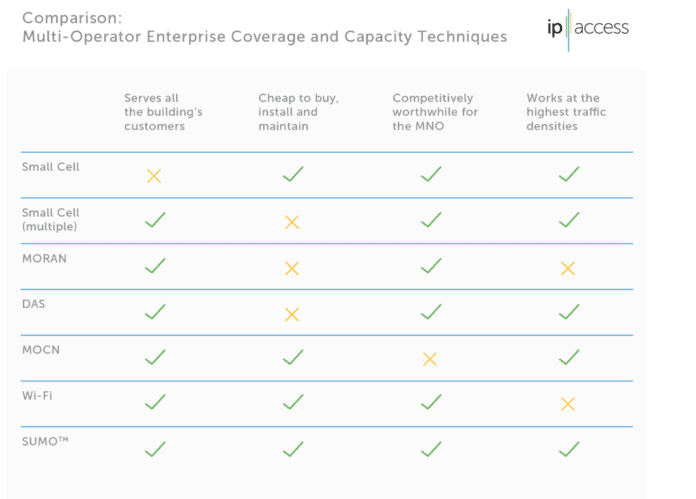Small cell deployments have lagged behind projections for years. Carriers are largely using the devices to provide pinpoint demand and capacity, but in terms of providing a multi-carrier solution, most commercially available small cells require infrastructure for each carrier. However, companies like Baicells, SpiderCloud Wireless, ip.access and others are working to evolve multi-carrier small cells beyond just customized housing to true, integrated multi-carrier support.
At the recent Small Cell Forum event, Ip.access took home an award for “outstanding innovation in small cell business case” for its Super Multi-Operator solution, which enables shared access small cells. According to ip.access, with SUMO “each access point broadcasts multiple PLMN codes on the same spectrum and all users see the AP as a cell within their home network. A policy based resource scheduler in the AP allocates capacity and bandwidth according to predefined rules managed via SLAs. The Viper gateway then securely routes all traffic to the appropriate core network for each operator.”
The ability to share radio and spectrum resources enables a neutral host business model, which, according to research into SUMO conducted by Wireless 20/20, can provide capex and opex savings of up to 80% as compared to other deployment business models.
Subscribe now to get the daily newsletter from RCR Wireless News
Ip.access CTO Nick Johnson said the company is working to address in-building wireless connectivity needs. “Providing adequate in-building coverage,” he said, “is one of the biggest issues facing operators and the wider wireless industry today, especially in so-called ‘middleprise’ venues. The neutral host is vital to solving these challenges and SUMO has been developed specifically to enhance their value proposition.”
The “middleprise” is a term coined by SOLiD Technologies and refers to building spaces — hospitals, retail, office space, residential and so on — that are between 100,000- and 500,000-square-feet in size. This market is largely seen as desperate for strong in-building cellular covearge but largely unable to attract carrier investment, which means connectivity would likely come from either a neutral host deployment or from an enterprise-led investment.

